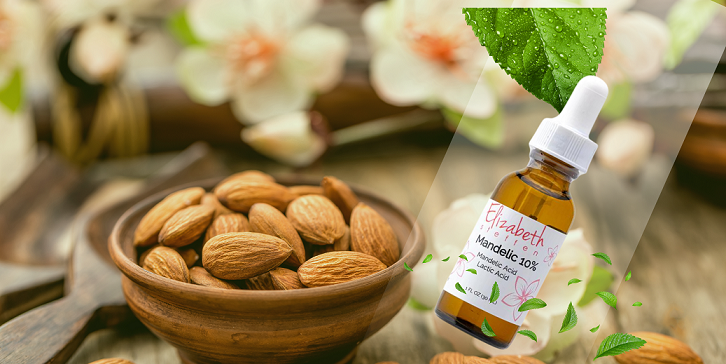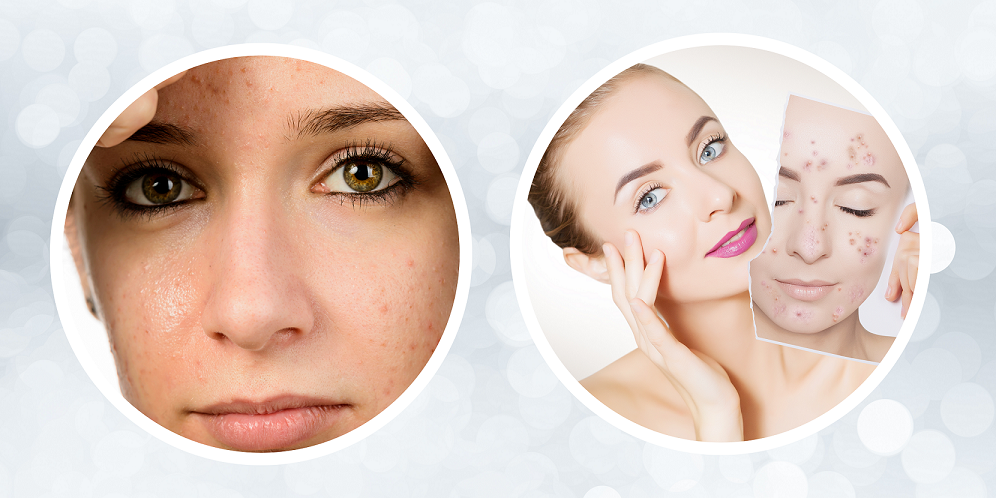
Clear Skin Ahead: The Power of Mandelic Acid for Acne Relief
At my spa, I've seen many women hiding behind layers of makeup and feeling self-conscious about acne. There is a secret ingredient many still don't know about and that is mandelic acid. In this article, you'll discover the transformative power of mandelic acid for acne, a gentle yet effective treatment suitable for even the most sensitive skin. I'm going to share the story of this remarkable alpha hydroxy acid derived from bitter almonds and to help you unveil the clear, radiant skin you’ve always desired.
Key Takeaways
Mandelic acid is an effective, gentle alpha hydroxy acid suitable for sensitive and acne-prone skin.
It has anti-inflammatory properties, exfoliating capabilities, and collagen production promotion to reduce acne scars, fine lines & uneven skin tone.
Dermatologists and acne specialists recommend mandelic acid as a powerful solution for treating acne with visible results in 1 to 3 weeks.

Unveiling the Power of Mandelic Acid for Clear, Glowing Skin
Mandelic acid, derived from bitter almonds, is a great alternative to other acids for acne-prone skin due to its gentler alpha hydroxy properties. Its larger molecule size means it penetrates the skin more slowly and less deeply compared with glycolic acid providing a milder exfoliation experience. It breaks the bonds between dead skin cells, allowing them to shed easier, revealing a smoother, healthier complexion beneath.
Using mandelic can be beneficial in treating inflammatory acne, sun damage, and hyperpigmentation because of its antibacterial abilities that eliminate acne-causing bacteria and anti-inflammatory powers, which reduce redness plus inflammation in prone complexions. Individuals taking Accutane or those with irritated skin should avoid using this versatile powerhouse skincare ingredient, though.
Unveiling the Benefits of Mandelic Acid for Acne-Prone Skin

Close-up of acne-prone skin before and after mandelic acid treatment
Mandelic acid is perfect for acne-prone skin as it offers powerful anti-inflammatory properties that target and reduce redness and irritation, as well as improve texture. Collagen production increases due to cell turnover, which can minimize the appearance of scars or wrinkles while evening out any uneven tone in your complexion. Its exfoliating effects enhance all these advantages, making mandelic acid a great choice when striving for healthier-looking skin.
The Anti-Inflammatory Edge
Those with delicate skin, as well as those with deeper complexions, will benefit greatly from the use of mandelic acid. Unlike other potent acids such as lactic acid, which can cause inflammation and a disproportionate amount of melanin in the skin’s surface layer when used incorrectly, this gentle compound has anti-inflammatory properties that soothe inflammations associated with acne flare-ups. The result is an even complexion without redness or irritation triggered by these same harsh ingredients found elsewhere.
Enhancing Skin Texture and Tone
Mandelic acid can be used to help all skin types achieve a smoother, younger-looking complexion by removing dead cells. Chemical peels with mandelic acid are one of the most popular options for this task as they work gently and efficiently compared to other treatments that might not cater well to specific skin sensitivities or problems. When people come to my spa with acne, many are also dealing with sensitivity issues, so it's a fine balance of getting skin clear without causing any side effects.
How Mandelic Acid Compares to Other Acids in Acne Care

Mandelic acid is a great choice when it comes to treating acne and dealing with clogged pores, particularly on sensitive skin. Its antibacterial abilities make it especially suitable for battling the bacteria-related kind of breakouts while its larger molecule size makes exfoliation gentle enough even for those who have had troubles with other acids such as salicylic or glycolic in the past. One of my favorite reasons for including mandelic acid is that it helps treat folliculitis, also called fungal acne. Folliculitis is a bacterial infection of the hair follicles, also known as Staphylococcus aureus (staph).
Research has proven that mandelic acid is just as effective against acne as some better-known remedies containing retinoids would be. So if you’re prone to irritation or sensitivity from using other kinds of acidic solutions – consider switching to this gentler but still totally capable option instead! I do carry one product that has retinol in it, called Rescue and Repair Serum. This is also formulated with a low dose of salicylic acid, niacinamide for inflammation and vitamin c for healing. I will sometimes have my clients rotate between using a mandelic acid serum and the Rescue and Repair Serum because the skin is complicated when it's battling acne. It's also another way to eliminate dead skin cells that are trapped in the pores and also helps with skin irritation.
Tailoring Your Routine: Incorporating Mandelic Acid Products

Selection of mandelic acid skincare products with different concentrations
To achieve maximum effectiveness, it's crucial to incorporate mandelic acid into your skincare routine correctly. Tailoring the concentration to your specific skin type is essential, and amplifying its impact by pairing it with compatible products like moisturizers or sunscreens can significantly enhance your complexion. I start all my acne clients off using mandelic acid every other day for 2 weeks as this allows for the skin ample time to adjust slowly and safely. Remember what I said about skin sensitivities? I do prefer to work directly with my clients as I can personalize products for each individual. However, I do have comprehensive Acne Coaching Programs that allows someone to guide themselves to clear skin.
If you are interested in exploring my Mandelic Acid offerings, check these out: Mandelic 10% and Mandelic 15%. If you're seeking comprehensive guidance, check out my Acne Coaching Programs. These self-guided programs are a perfect choice when trying to clear your acne, and you don't live near an acne specialist.
Choosing the Right Concentration
If you’re new to mandelic acid, it’s recommended that you begin with a low concentration such as 10%, especially when your skin is delicate. As your skin adapts to its effects, gradually increase the strength until optimal results are achieved.
After every application of this acid, don’t forget to follow up by applying moisturizer on your face and sunscreen for extra protection from damaging UV radiation. Because mandelic acid is an alpha hydroxy acid, it will increase sun sensitivities.
Combining with Complementary Skincare
When implementing mandelic acid into your skin care regimen, it is essential to combine it with other ingredients to help achieve the skin you're looking for. For example, if you have acne, using a benzoyl peroxide treatment is also essential for riding the skin of the P. Acnes bacteria. A good choice would be using the Clear Skin 10% for severe acne or the Clear Skin 5% which is formulated with sulfur for inflamed acne. I have my clients use a mandelic acid serum in the morning, followed by a non-pore-clogging sunscreen and use a benzoyl peroxide product in the evening.
Navigating Potential Side Effects of Mandelic Acid
When using mandelic acid in your skincare regimen, it is important to be aware of potential side effects. While this type of acid is well tolerated by most people’s skin, some may experience irritation or even photosensitivity if used incorrectly. To minimize the risks associated with its use, ensure that you do not overdo it and wear sunscreen every day, even when you are not going outdoors. Sunscreen also is formulated with hydrating ingredients which helps protect the skin from become dry and sensitive.
Should any symptoms such as redness, swelling, itching, dry flakiness peeling or general irritation present themselves after application. Immediately discontinue use and consult a dermatologist or your skincare professional. This will enable you to still reap the benefits of adding mandelic acid into your routine without suffering unnecessary repercussions on your complexion.
Real Results: Testimonials and Studies on Mandelic Acid's Efficacy

Before and after photos of skin improvement with mandelic acid
The countless positive reviews and studies prove that mandelic acid works wonders for the skin, helping to reduce acne breakouts, address hyperpigmentation issues, and erase fine lines. People who use it on a regular basis have seen visible results in as little as one or two weeks. I have been working with clients for nearly two decades now, and the results I have seen while working with acne clients is life-changing.
Accordingly, scientific research also confirms these favorable outcomes – demonstrating how mandelic acid is an excellent option when battling mild-to-moderate acne while simultaneously improving the texture and tone of the skin. With such powerful evidence backing up its effectiveness, there’s no denying why many people now swear by this special type of acid!
Expert Insights: What Dermatologists Say About Mandelic Acid
The endorsement of dermatologists and the many happy users can confirm mandelic acid’s efficacy as a vital element for skincare. Also, other licensed estheticians who are also acne specialists will attest to the benefits they have seen with using mandelic acid as part of the home care routine they will have their clients make use of. If you want to fight stubborn acne or achieve a healthy, luminous look, this type of acid is precisely what your skin needs. Because it features exfoliating and anti-bacterial abilities that work wonderfully on multiple skin types and issues such as hyperpigmentation caused by inflamed acne breakouts, fungal acne (folliculitis) and even wrinkles for anti-aging. Consequently generating a fantastic outcome in various cases, people have experienced visible results with using mandelic acid!
Summary
Mandelic acid is a perfect choice for skin problems, particularly acne. Its anti-inflammatory properties will help improve texture and tone. Evidence from experts, users’ reports, and studies confirm the effectiveness of this gentle yet effective treatment, regardless of what type or condition your skin may be in. With mandelic acid, you can achieve a clear complexion free from blemishes so that your natural radiance shines through!
Frequently Asked Questions
Will mandelic acid help acne?
Mandelic acid, an alpha hydroxy acid that is less harsh than other acids used in treating acne, can help reduce inflammation and redness while removing bacteria associated with causing breakouts. It’s also beneficial for those with sensitive or dark skin tones who are prone to hyperpigmentation due to its gentle nature.
Which is better Salicylic acid or mandelic acid?
When it comes to treating acne, the kind of acid that should be used depends on whether your particular issue is inflamed or not. Using a topical mandelic acid treatment is recommended for cases involving inflammation whereas salicylic acid will usually work better against non-inflamed forms. However, from my experience many people who have acne often have a combination of both.
Which is better mandelic acid or vitamin C?
Mandelic acid is a great way to help with skin texture and tone since it can break down the connections between lifeless cells. On top of that, vitamin C encourages collagen production, which also aids in improving skin condition. Both are powerful approaches for helping you achieve a better-looking complexion! So if you’re trying to get rid of dullness on your face, using mandelic acid or Vitamin C could be just what you need.
What makes mandelic acid different from other alpha hydroxy acids?
Mandelic acid, characterized by its larger molecular size compared to other alpha hydroxy acids, offers a more gentle and gradual exfoliation process, making it an effective acid for skincare. Derived from bitter almonds, this alpha hydroxy acid (AHA) stands out from counterparts like glycolic and lactic acids due to its unique properties. Particularly beneficial for individuals with sensitive skin, mandelic acid's larger molecular size ensures a milder exfoliation experience. Additionally, its distinctive antibacterial properties make it a valuable choice for addressing concerns related to acne. In contrast, glycolic acid, possessing a smaller molecular size, provides a deeper exfoliation that targets issues such as fine lines and hyperpigmentation. Selecting between these AHAs involves considering individual skin types, specific concerns, and the desired level of exfoliation.



